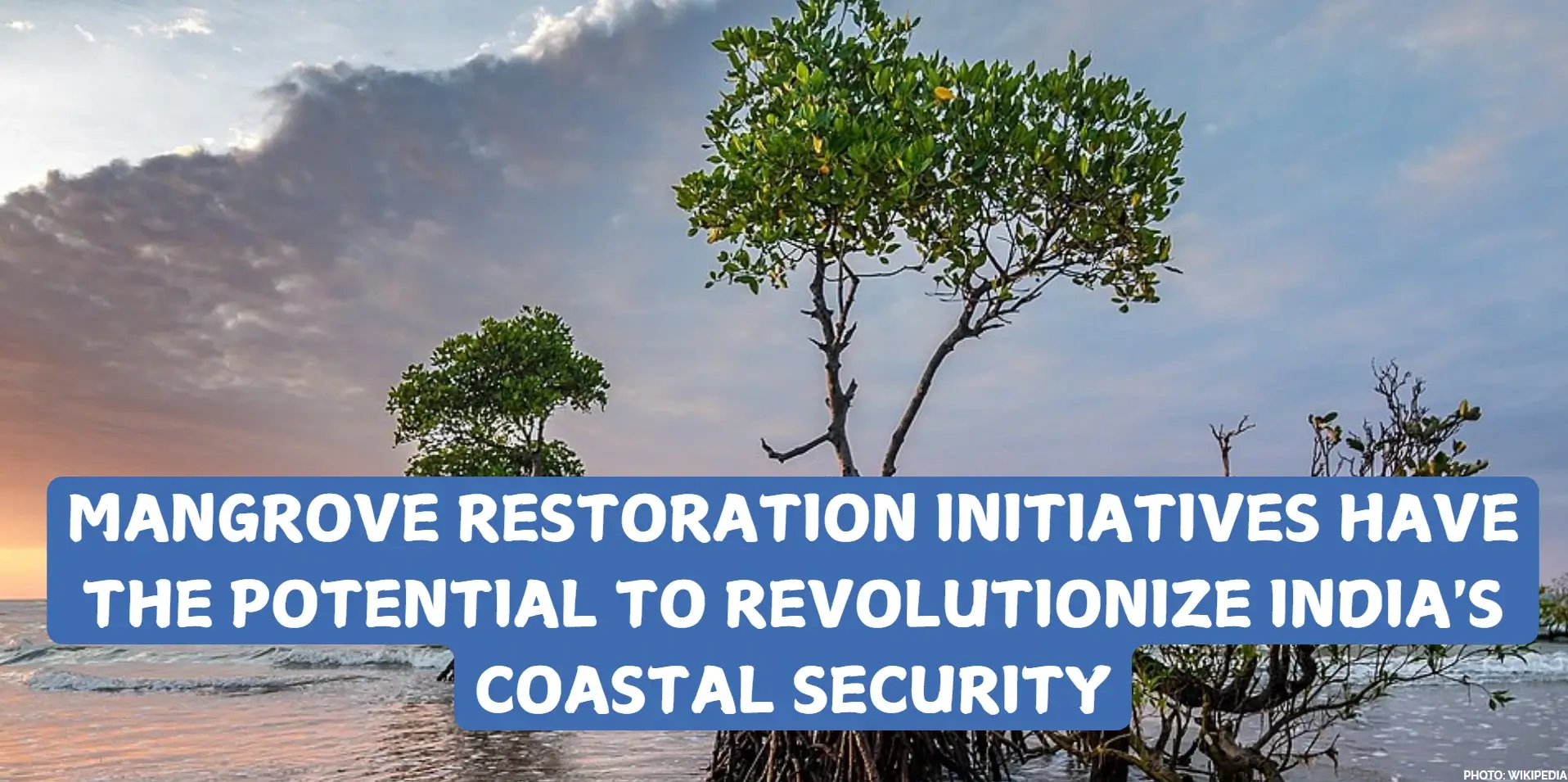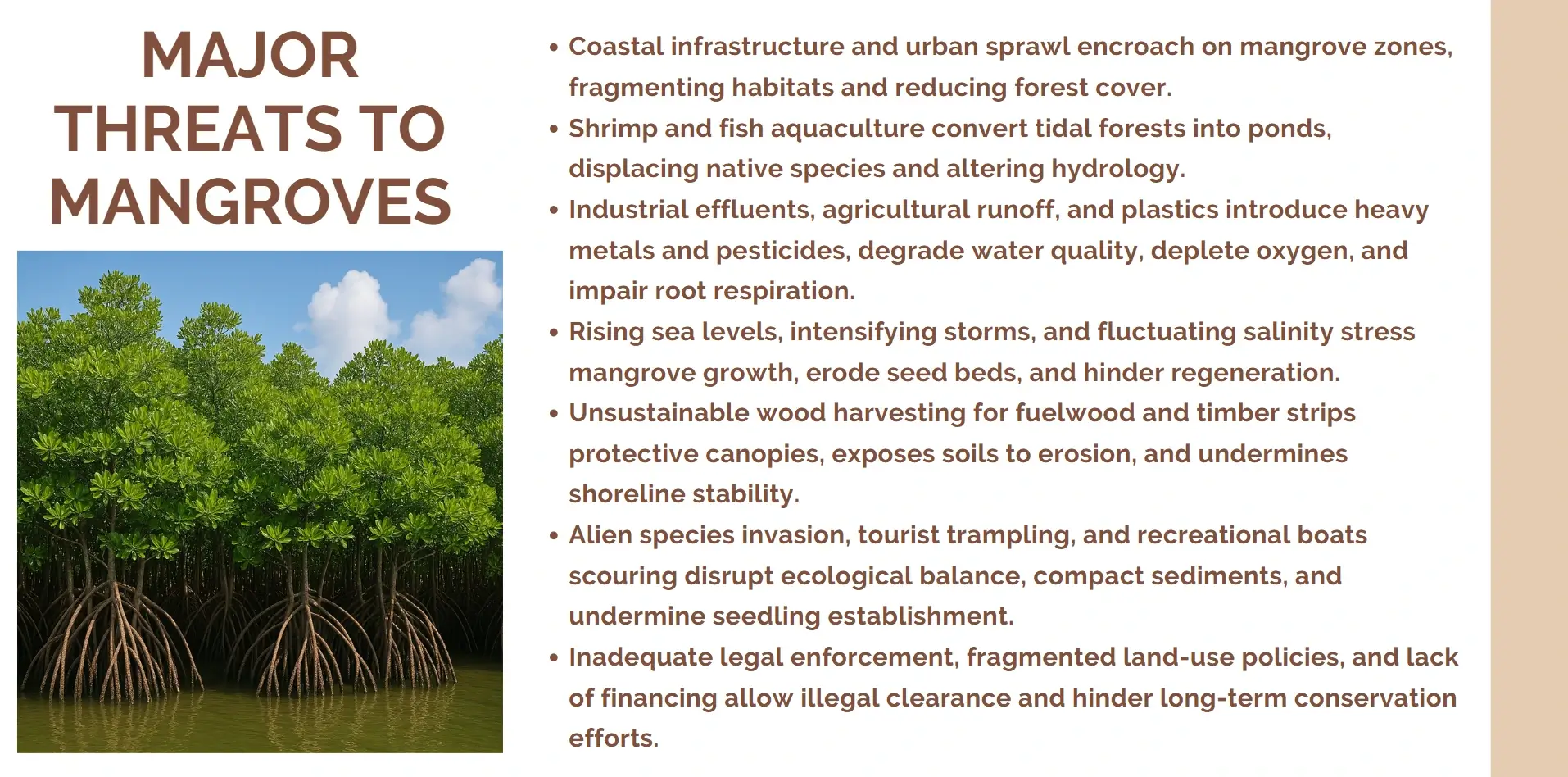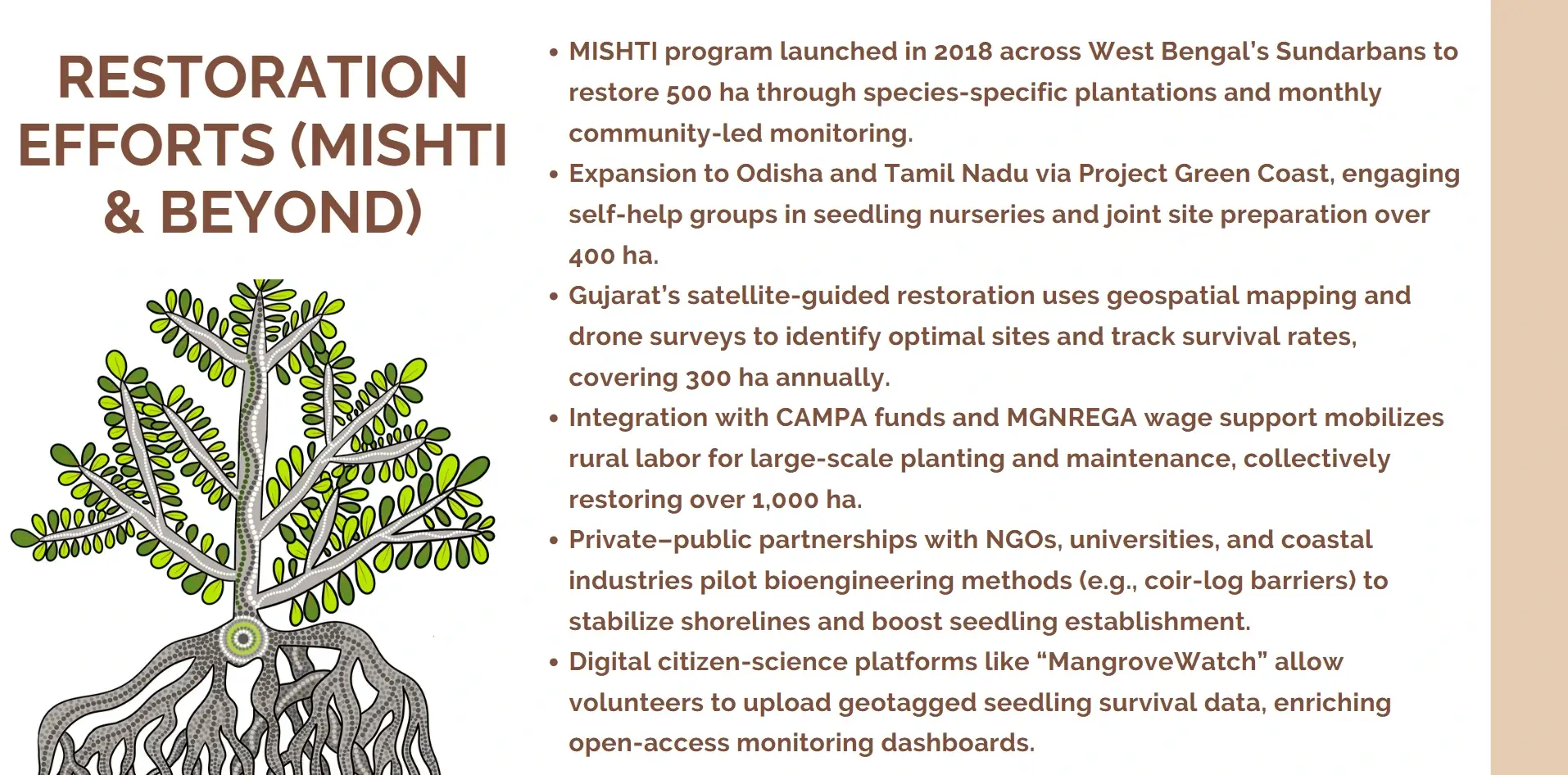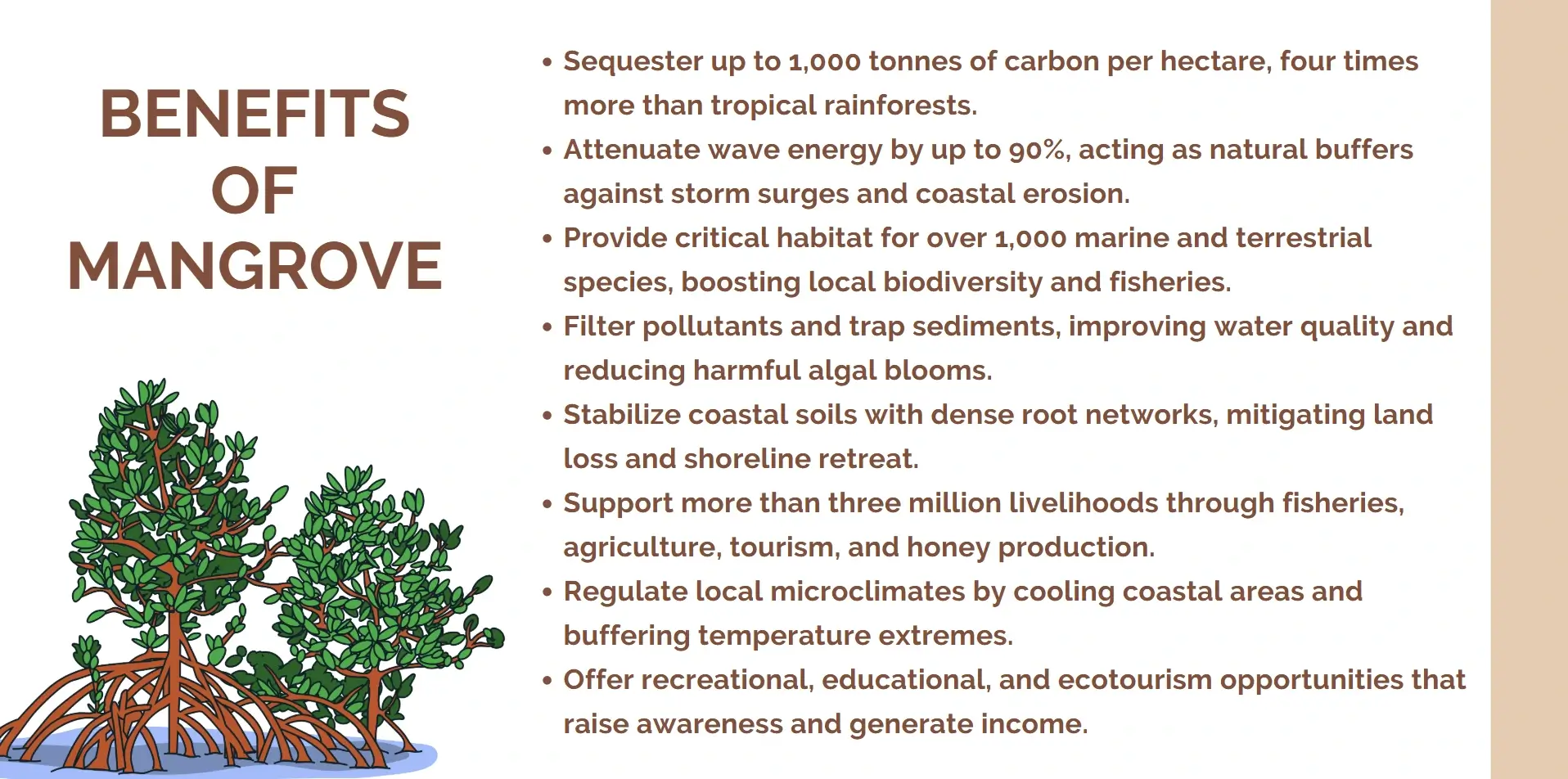Restoration of mangroves in India enhances coastal security, biodiversity, and climate resilience and this is one of the strong reminders of it on July 26.

On Twenty sixth of July every year an important day is being celebrated to mark the importance and restoration of mangroves as international day to conserve mangroves. Shading more than 7,500 kilometre, Indian coastal line, mangroves play important barricade roles between land and sea. They protect coastal towns by cyclone protection, tidal surges and coastal erosion and support marine biodiversity and remove large quantities of carbon dioxide.However, mangroves are fading because of unintentional city advancement, waste dumping, fish farming, and tidal leakage under a push to meet the demands of livelihoods and national security. The Sundarbans, the estuaries of Maharashtra and the Andaman & Nicobar Islands are living examples of a critical potential of dangers as well as hope to these green sentinels.In this article, an argument is presented aboutreplenishing mangrove forests is not only an ecological goal, but a strategic need of India. With the help of threats, policyframeworks, restoration achievements, and the gap that is still left the case is built of the establishment of a coordinated and multidisciplinary effort to restoring these resilient natural sentinels..
Why Mangroves matters?
Not only is mangroves coastal vegetation, it is also a multi-functional ecosystem that protects, nurtures and stabilizes not only the community but the shorelines, which are a combined package of ecological, economic and even strategic advantages.
Ecologic pillar
Mangroves have high biodiversity and harbor crustaceans, mollusks, or even breeding fishes that are important in coastal food webs. Their intertwining roots offer secure youth habitats to young marine life and migratory birds as well as endangered mammals. At the same time, the mangroves are strong carbon reservoirs. They sequester the carbon in the atmosphere many times more readily than do tropical rainforests, concealing their atmospheric stores of carbon in the soils, and forestalling decades of climate change in so doing.
Leading Edge
Among the most expeditious and conspicuous services of mangroves, it is possible to indicate their work in buffering the shorelines. They absorb energy of waves, lower floods in a cyclone and fix sediments to stop erosion. During the high intensity storms, mangrove belts have also saved lives and property in regions such as Odisha and Sundarbans. Their large root systems retain debris and retain saltwater incursion, safeguarding freshwater underground reservoirs and agronomic sustainability along the interior of the country.
Local Prosperity and Economics
Mangroves are life lines to coastal communities. Fishing is also a main source in mangrove attached water, improving the income of more than 1.5 million people in India alone. Besides, honey, crab farming, medicinal plants, and eco-tourism ventures that are based on mangrove landscape will serve as extra sources of income particularly in the rural settings. Marginalized groups also benefit through the means of food security and poverty decrease caused by the natural productivity of the ecosystem.
Strategic Value
Within a national planning setting, the mangroves strengthen the national maritime borders of India. This capability to cushion against climate-related risks such as rising sea level and mounting cycloneactivity makes them a natural infrastructure. Mangrove restoration is not only environmentalism, it is also environmental security. Since climate volatility is on an upward trend, these landscapes turn into muffled scouts of strength and independence.
Current Status
The mangroves ecosystems of India and the whole world come under re-examination, faced with rising climatic threats and urban developments. .
- India has about 4,975 sq. km of mangroves spread in 9 coastal states and union territories chief among them being West Bengal, Gujarat and Maharashtra.
- Sundarbans are considered to be the biggest continuous patch of mangrove tree forests in the world but are currently at risk due to invasion of salt water and erosion.
- Although mangroves in India are making good progress towards protection (we have more than 80 percent of mangroves maintained under legal conservation area) the fragmentation and encroachment persist as the urban population pressure, aquaculture activities and construction of infrastructural facilities gather momentum in the country.
- It is common to have poornatural regeneration without active restoration particularly in degraded patches.
- The population of mangroves all over the world has decreased by more than a third in the last several decades, even though nations such as Indonesia and Bangladesh are going into community-led restoration initiatives.
- This is also seen in India through its home-grown efforts, like attempting to use mangrove areas in the Mangrove Initiative of Shoreline Habitats & Tangible Incomes (MISHTI).
- Satellite surveillance, carbon emissions trading, and small-scale custodianship are becoming a set of strategic instruments but there remain space in enforcement, finance, and workforce.
- To be brief, mangroves are a point of intersection between what is biologically strong, but politically ignored. The key to reinforcing their position is to combine science, policy and grassroots action in urgent and sustained manners.

Framework of Policy and Restoring Efforts
The world is increasingly becoming strategic in conservation of mangroves. Current changes in Indian policy combined legal protection with new restoration instruments and attempted to reconcile ecological restoration and development focusing on communities.
Legal Requirements
In India, the mangroves have been safeguarded by various legislations like Forest Conservation Act in the year 1980, Environment Protection Act in the year 1986 as well as the Coastal Regulation Zone (CRZ) Notification. CRZ rules have also banned any developmental activities in areas that fall into designated mangrovesareas thereby protecting delicate areas of mangroves against industrial invasion. Nevertheless, due to lack of uniformity and some jurisdictional issues, they tend not to fulfil their full protective capacity.
Repair Initiative
The MISHTI that has been introduced in the 2023 is a policy change that implies active ecosystem restoration. It combines mangrove plantation and livelihood creation in the climate-hazardous districts and focuses on participatory approaches and nursery establishment. MISHTI is a complimentary initiative to the existing programs such as CAMPA (Compensatory Afforestation Fund) and MGNREGA wherein planting mangroves under the green jobs initiative is promoted.
Levels of Community Participation
Some progressive states such as Odisha and Tamil Nadu are experimenting with decentralized restoration using fisher communities and young groups in planting, monitoring and stewardship. These bottom-up initiatives are adaptive, consistent with traditional knowledge systems, and social buy-in. Combined with community data, there is a potential in dynamic restoration planning with satellite-based mapping of mangrove.

Policy Synergy
The boundaries between restoration programs and climate policy as well as sustainability objectives are becoming more blurred. The mangroves are one of the components that are included in National Biodiversity Action Plan and the Indian State Action Plans on Climate Change (SAPCC), where their protection has been connected to disaster risk reduction and carbon sequestration. Nonetheless, it is crucial that policy coherence among the environmental ministries, the local with financial institutions, is achieved to increase the scale of impact and resilience.
Monitoring & Impact
Transformation and the restoration of mangroves require more than restoration; efficient monitoring and assessing the effects are needed to ensure long-term ecological, social and climatic payoffs.
Technological Surveillance
The process of monitoring mangroves has reached a new stage as remote sensing tools are at the center. India uses reports from the Forest Survey of India and satellite systems like ISRO BHUVAN to produce maps showing the variations in mangrove cover and health. These resemble devices that are useful in identifying unlawful encroachments, estimating biomass loss, and analysis of climate data. Satellite feeds are becoming more supplemented by ground based sensors and drone mapping systems which can in real time retrieve location-specific data that helps in policy planning as well as disaster prevention.
Ecological Impact
Impact assessments concentrate on the ecosystem functionality (particularly regeneration of the biodiversity, filtration of water or trapping of the sediments). Research indicates that after replenishing mangroves there is increased concentration of young fish and enhanced soil carbon storage. Mangroves are also major contributors to the regional hydrological stability, through saline intrusion reduction, and aquifer subsidizing. Their success nevertheless depends on species heterogeneity, hydrological synchronicity as well as long term survival estimations that involve high ecological inspection other than the tally of trees.

Social and Economic Outcomes
Monitoring does not only exist on trees and tides, but even in communities. Participatory impact studies assess how mangrove associated employment, eco-tourism and crab farming to improve the lives of the coastal communities. Integrated solutions can be seen in Odisha and Gujarat where the income stability of local citizens and climate readiness are more successful. The agenda of gender-inclusive data collection is used to reveal the increased role of women in nature-related businesses, which secures social justice based on nature-related solutions.
Policy Feed-back Loop
Practical implications are quantifiable and popularize reforms. Monitoring ensures that programs under implementation such as MISHTI and CAMPA are functioning well so as to detect areas that need covered finances. Developing open-data mangrovedashboards, the investments in the GIS training of local authorities, and the common metric recognition between states will make the mangrove future of India evidence-based as well as toughly regulated.
Issues and Policy Suggestions to Sustainability
The mangrove forest system experiences numerous institutional, ecological as well as structural challenges. The best possible way of solving these issues is to innovate policy on multiple levels and at all levels in responsive governance that would have local, national, and international coordination.
Structural obstacles
Most mangroves are in contested landscapes or ecologically fragmented landscapes. Ecological zoning is usually outshone by coastal infrastructure, aquaculture development, and tourism development. The uncertainty associated with the classification of land regarding the classification of mangroves as wetlands, forests, or revenue land is a source of jurisdictional wrangles and poor enforcement. To protect these zones, it is very crucial to restore legal certainty and to simplify institutional mandates.
Ecological Challenges
Poor species selection in reforestation comes up in many cases, without giving emphasis to hydro-logical and salinity changes. The non-native species can erode against biodiversity and ecosystem services. Also, the climate change comes with the higher salinity, rising level of thesea and random storm occurrence. The emphasis of restoration should be on the environmental compliance, planting smart and locational as well as adaptive methods such as mixing planting species, and regulating the flow of these tides.
Governance and Finance
In the practice of a top-down scheme, it neglects grassroots involvement that eventually leads to the low community ownership and lapses in monitoring. Funds harnessed at CAMPA, MGNREGA or at MISHTI may slow down or become irregular. Demonstrating a successful activity, they could get faster results by organizing local stewarding with micro-grants, skills training, and access to carbon credits. Special mangrove cells in the state forest departments could promote interagency coordination.
Recommendations
Climate, livelihood, and biodiversity objectives should be captured in a forward vision of a mangrove policy. Important steps are:
- Reclassification of law to address the two overlap land ownership and protection issue
- Regional hydrologic-specific ecological restoration standards
- Real-time monitoring dashboards Community co-management models
- Motives of participation in blue carbon markets used by the private sector
- Integration of mangrove indicators in climate-resilient and disaster preparation.
- Comprehensive, integrative approaches can help convert mangroves into the pillars of coastal sustainability, no more vulnerable ecosystems.
Conclusion
Mangroves are not ecological fossils but rather living systems relating to climate resilience and livelihood security besetting the coasts of India in this clubbing effect of climate change and coastal governance. Ranging carbon sequestrations and biodiversity through disaster mitigation and uplifting of the socio-economic levels, their multi-faceted importance cannot be contested. There is a good basis provided by the restoration project such as MISHTI and enhanced satellite-monitoring, yet the areas of concern are ecological accuracy, land-use comprehension, and policy interaction.In the future, India should apply integrated mangrove approachCorridor between local management and national policies and global climate plan. The key to sustainability is empowering people, uniting blue carbon finance and institutionalizing the real-time evaluation of impact.With a planned protection and development, mangroves can develop into formidable fortresses of environmental sovereignty, as opposed to weak and vulnerable ecosystems. They are not just important, but they are the foundation of hope, inheritance and survival in a world that is growing more and more climate-uncertain. Mangrove investments are ecological investments in the country.